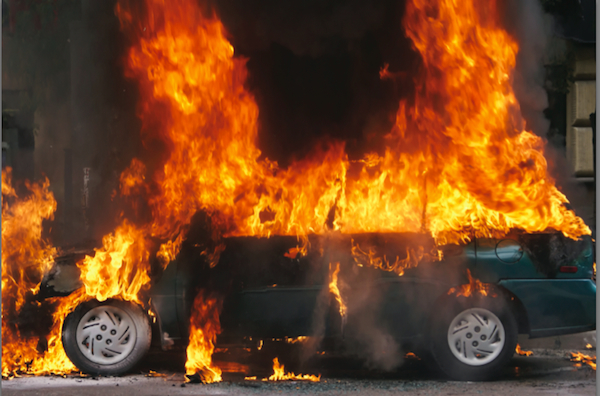
Photo by: USFA
The U.S. Fire Administration estimates that 27,900 intentionally set vehicle fires occurred each year in the U.S. from 2004 to 2006.
This story is part of a reporting project conducted jointly by City Limits and a team of students at the City University of New York Graduate School of Journalism.
With the smell of burned wood and plastic lingering in the air and the damp ashes of someone’s home underfoot, fire investigators enter a scene knowing what they’ll find. After a fire, the patterns on the walls offer clues about how and where the flames traveled. Investigators look at those blackened marks shaped like V’s – to put together the pieces of what happened. For many years, a narrower angle in the V was says to be a sign that the fire had burned hotter and faster than was natural. A slender V meant arson, they’d say, backed up by several well-known texts published prior to 1992.
They were wrong.
Fire investigation has come a long way, but some investigators think it still has farther to go—and that fire sleuths need to know a little about fire science.
“The vast majority of fire investigators today do not make that standard,” says John Lentini, a fire science expert and private fire investigator based in Florida. “A lot of them couldn’t tell you how much energy it takes to light a room.”
Lentini thinks that most fire units do not devote enough resources to the science of fire investigation. He has spent much of his career promoting more science and less conjecture in arson cases as both an author and a consultant. In 2010, he helped posthumously exonerate Cameron Todd Willingham six years after Willingham was executed for arson in Texas.
Junk science plagued fire investigations for decades, and is blamed for dozens of questionable arson convictions. Lentini lists several such miscarriages of justice in a 2012 paper published in the journal, Criminal Justice. But even as old cases are overturned, fire investigations have evolved to more scientific practices, dismissing flawed past methods. Today investigations take longer and cost more, and standards are higher for proving criminal cases.
Despite new methods, the principal goal for fire investigators is the same: to figure out how and where the fire started.
Junk science of the past
Up until recently, process of elimination – or negative corpus – passed as a reasonable way to prove an arson case. It was removed from the National Fire Protection Association’s fire investigation manual in 2011.
“In the past it was an accepted practice,” says Bob Duval, a senior fire investigator at the NFPA, the Massachusetts based trade organization that publishes the nation’s most widely accepted guide for investigating fires.
“If you didn’t have any viable source of ignition then it had to be arson.”
Negative corpus, some argued, was part of the scientific method – a science-approved way of ruling arson without any specific evidence.
Similarly, when investigators couldn’t find an ignition source, some came to rely on evidence that indicated that a fire had burned especially hot or fast. Hot, fast or low burning fire indicators became telltale sign of arson, Duval says.
“If you have a fire up against a wall in a waste basket filled with newspapers, the fire spreads as it goes up and makes a V mark on the wall,” he says. “One myth was if that V was narrow, that meant it had to be arson — a fast fire.”
But what is a fast fire? The definition didn’t exist at the time and still isn’t backed by scientific research. More factors play into a fire’s speed than the use of gasoline. A jolt of air from a suddenly burst window or contact with combustibles like fabric or newspaper can affect fire’s behavior as dramatically as a can of petroleum.
Evidence that suggested a hot fire also inspired suspicion of arson. Melted metal, shiny, alligator-like patterns on wood or crazed, or cracked, glass in windows were all sure signs that gasoline or rocket fuel must have been used to accelerate the inferno.
“If I see crazed glass on a report then I know I’m dealing with a bona fide idiot,” Lentini says.
The shattered glass is caused, not by extreme heat, but by extreme cooling – like when water from a fire hose hits hot glass.
The expression “hot fire” is also questionable, says Duval.
“Define a hot fire,” he says. “If you touch it, does it burn your hand?”
How investigations work today
Real fire investigations lack the glamor and speed that they do on television, investigators say. Detecting the source and origin of a fire is a process, and one that can become highly meticulous and technical when done right.
“It takes a lot longer than it does on CSI,” says Duval. “Some of these things are very tedious and it’s piecing together tiny pieces of evidence.”
Two texts, both produced by the NFPA, set the standards for the who and how of fire investigation. The first, NFPA 921, was published in 1992 and is a detailed how-to manual for conducting a fire investigation. The second, NFPA 1033, sets the skill qualifications for investigators.
“You might call it the Bible of how to conduct a fire investigation in North America.”
Chasing Fires
Read the CUNY J-School team’s full report on arson in New York City, then and now.
Ken Willette, a former fire chief and manager of the NFPA’s Fire Protection Division, says that “921 really focuses on scientific method and promotes it.”
Lentini calls NFPA 1033 the minimal requirement for fire investigators, but thinks that most departments don’t invest enough into doing the work that a proper and thorough investigation requires.
“We get firemen and fire investigators and those are two different skill sets,” he says. “If you don’t have the education to understand your training you’re not going to be a good investigator.”
That slow and methodical approach to fire solving isn’t always feasible in big cities, where fire marshals are tapped to investigate high volumes of fires. The FDNY’s Bureau of Fire Investigation reported that their 120 fire marshals took on more than 6,000 cases in 2012.
One fire marshal in the department described a triage system, where time and resources depend on the severity of a case. Speaking without authorization from the FDNY, he requested his name not be used.
“When we walk into a room, we start at the area of least damage and move toward the area with the most,” the fire marshal says. “Sometimes you have to stand back first.”
The path of destruction tells a story
“In the eyes of a layperson, it’s destroyed but in the eyes of an investigator, there are clues and patterns,” Duval says. “What the fire is doing to the material tells us a lot about where it burned and where it came from.”
As investigators walk through a room, they observe and rule out potential fire sources like they’d go down a checklist. Was the iron plugged in? Was the circuit box damaged? Was the smoke alarm turned off? In some cases, investigators will go through the site shovel by shovel and send samples to a forensics lab to test theories or rule out accelerants.
“It’s an intense, time-consuming process,” the fire marshal says. “There’s a heavy caseload and a lot to do. Things higher on the priority list have to come first.”
BFI investigators might linger, he says, in a densely populated high-rise more than they would in a two family structure fire with minimal injuries to residents.
The method, investigators say, is to develop a theory based on evidence and prove it to be fact.
Solving the case
When a fire’s cause and origin are known, investigators say ruling it accidental or intentional isn’t difficult.
“Usually if the fire is caused by arson, it doesn’t take that long to figure it out,” Lentini says. “People use flammable liquids like gasoline a lot of the time and it’s pretty easy to detect. Or they’ll start the fire in more than one place thinking it’ll burn the same way and it doesn’t – if you have three origins you can pretty much say it’s an arson.”
Video: Remembering the Happy Land tragedy
In New York, arson cases are built with more than the physical evidence at the crime scene. BFI fire marshals have full police authority and use subpoenas and criminal databases to collect phone data, EZ pass statements, employee lists and surveillance footage that help them find suspects.
“We do all these things like a checklist, often before they think about it,” says one fire marshal. “People trip themselves up very easily.”
But some suspicious fires are more open ended.
“If you can’t find the ignition source, you make it undetermined,” Duval says.
“It’s just a fact of life.”
And sometimes, even with modern methods, fires can’t be solved.









2 thoughts on “Arson Investigation Techniques Catching Up with Science”
Pingback: How Arson Investigation Has Changed | Independent Lens Blog
Fires could be mistaken for incidental incidents when it could be arson.